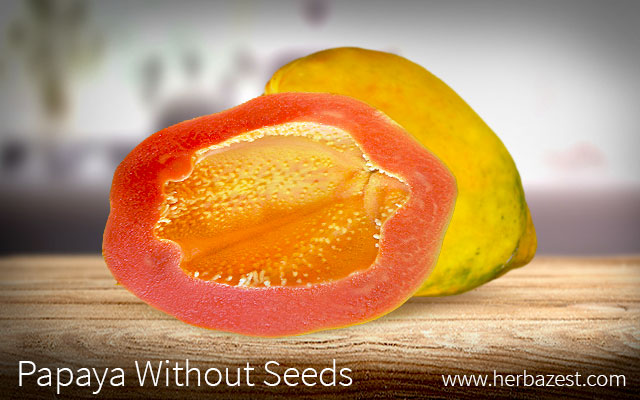Reproductive habits, plant variety, and growing environment are the most influential factors in the development of seedless papayas. Although mind-bogglingly complex in its biology, a papaya without seeds taste as good as other types of papaya and are highly valued on the commercial market for tropical fruits.
Where Do Papayas Without Seeds Come From?
Many of the seedless papayas that can be found in grocery stores and markets have been developed by experienced botanists under ideal greenhouse conditions. This is because incidences of papayas without seeds take place very rarely in the field.
IN THE NATURAL CONDITIONS, PAPAYAS WITHOUT SEEDS ARE BIZARRE PRODUCTS OF UNFERTILIZED PAPAYA FLOWERS.
The vast majority of plants usually self-abort if fertilization cannot be achieved. However, when a female papaya plant develops a fruit despite having unfertilized ovules, it is considered asexual. This unusual condition is termed parthenocarpy. In those rare instances, volatile phytohormones support the development and even the maturity of papayas with no seeds. Exhibiting adequate sweetness and quality, they are not unlike some of their seed-bearing counterparts.
Thought to be a hybrid mix of two Andean papaya varieties, the babaco, or 'mountain papaya', is a prominent example of a papaya without seeds. With a subtle essence of strawberries, bananas, and pineapple, it has been called 'the champagne fruit' for its slightly citrusy or acidic flavor. Its international acclaim took root during the early 1970's when researchers introduced imported Ecuadorian cuttings to New Zealand.
Genetically complex and bright yellow when mature, the babaco is also able to produce fruit without fertilization, making it 100% seedless in all cases. This type of papaya, without seeds, has experienced great commercial success in New Zealand, Spain, Israel, Italy, and even warm regions of the United States.
Papayas with and without Seeds: Differences
With all-female flowers that play a role in its reproductive nature, the babaco also contains a higher concentration of the enzyme papain.
Because papayas without seeds spontaneously grow from the same type of plants as those with seeds, they possess similar physical characteristics: mildly sweet fruits, with pink or orange flesh, and spherical and pear-like shapes.
Smaller, easier to eat, and with a longer shelf life, papayas without seeds hold an excellent commercial appeal. Not so easily reproduced in the field, however, much of the world's seedless papaya varieties come from mass propagation in vitro. Botanists and home gardeners use grafting and budding methods to grow known seedless types with the well-developed root system of a previously-planted papaya tree.
The babaco plant produces a five-sided fruit that resembles small stars when horizontally sliced. It has a soft outer skin that allows the fruit to be eaten whole.
Unlike the common field papaya, the babaco is much more tolerant to cold, damp weather, withstanding temperatures as low as 28°F (-2°C) in some cases. It forms a much smaller, dwarfed plant of up to six feet (1.8 m) in comparison with the 30-foot (9 m) tall papaya tree.
Although there is still much to be learned about why some papaya fruits are seedless while others are not, researchers have made important advancements in recent years that has led to a booming commercial market. Delicious and wonderfully mystifying, papayas without seeds have some unique characteristics that make them perfect little tropical treasures for anyone who can get their hands on them.
Sources
- American Society of Horticultural Science, Exotic horticultural plants with commercial potential in the United States market, 1996
- Breeding Tropical and Subtropical Fruits, p. 111
- California Rare Fruit Growers, Babaco, Carcica pentagona Heilborn, Caricaceae
- Greenhouse Gardener's Companion, p. 283 - 284
- North Carolina State University, Babaco | Grafting and budding nursery crop plants
- Nutrients, Seedless fruit production by hormonal regulation of fruit set, 2009
- Tropical Fruits, p. 302
- University of Hawaii, Why some papaya plants fail to fruit




